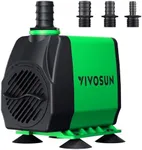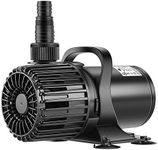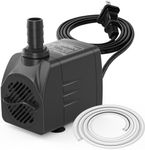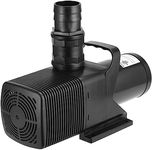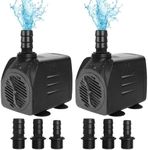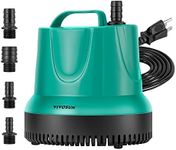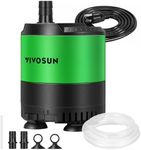Buying Guide for the Best Water Pump For Hydroponics
Choosing the right water pump for your hydroponics system is crucial because it ensures your plants receive a consistent and adequate supply of nutrient-rich water. The pump is the heart of your system, circulating water to keep roots healthy and oxygenated. When selecting a pump, you should consider the size of your setup, the type of hydroponic system you use, and how much water needs to be moved. Understanding the key specifications will help you make a choice that matches your needs and keeps your plants thriving.Flow Rate (GPH or LPH)Flow rate tells you how much water the pump can move in a given time, usually measured in gallons per hour (GPH) or liters per hour (LPH). This is important because your plants need a certain amount of water circulating to get enough nutrients and oxygen. Small systems may only need a low flow rate, while larger or more complex systems require higher flow rates. To pick the right flow rate, calculate the total volume of water in your system and aim for a pump that can circulate all the water at least once every hour or two. If you have a lot of plants or a tall system, you might need a higher flow rate.
Head Height (Maximum Lift)Head height, or maximum lift, is the highest point the pump can push water vertically. This matters if your system has vertical elements or if the water needs to be pumped up to a higher level. Pumps with a low head height are fine for flat or shallow systems, but if you need to move water up shelves or to hanging plants, look for a pump with a higher head height. Always check the distance from your reservoir to the highest point the water needs to reach and choose a pump that can handle at least that height.
Pump Type (Submersible vs. Inline)There are two main types of pumps: submersible and inline. Submersible pumps sit directly in the water and are easy to install, making them popular for small to medium hydroponic systems. Inline pumps stay outside the water and are better for larger systems or when you want to keep the pump cool and dry. Choose a submersible pump for simplicity and quieter operation, or an inline pump if you need more power or have a bigger setup.
Energy EfficiencyEnergy efficiency refers to how much electricity the pump uses to move water. This is important because your pump will likely run for long periods, and an efficient pump will save you on electricity costs and reduce heat in your system. Pumps with lower wattage ratings use less power, but make sure they still meet your flow rate and head height needs. If you want to minimize energy use, look for pumps labeled as energy-efficient and compare their power consumption to their output.
Noise LevelNoise level is how much sound the pump makes while running. This can be important if your hydroponic system is in a living space or somewhere quiet is needed. Submersible pumps are usually quieter because the water muffles the sound, while inline pumps can be louder. If noise is a concern, look for pumps that are specifically described as quiet or low-noise, and consider where you will place the pump in your setup.
Ease of MaintenanceEase of maintenance means how simple it is to clean and service the pump. Pumps can get clogged with debris or mineral buildup, so it's important to choose one that can be easily taken apart and cleaned. Look for pumps with removable covers and accessible parts. If you want to spend less time on maintenance, pick a pump that is known for being easy to clean and has good instructions.
